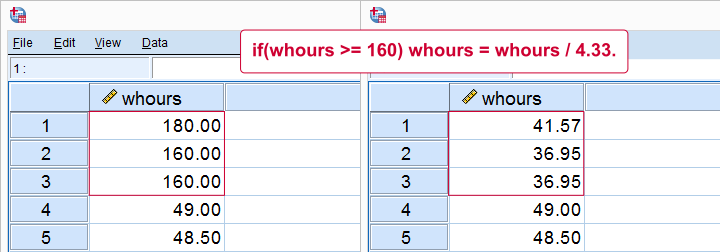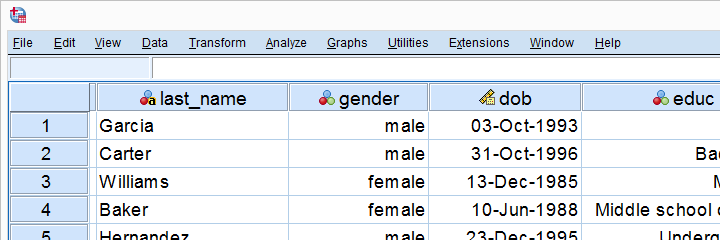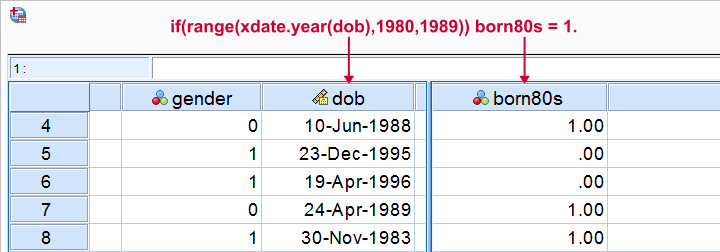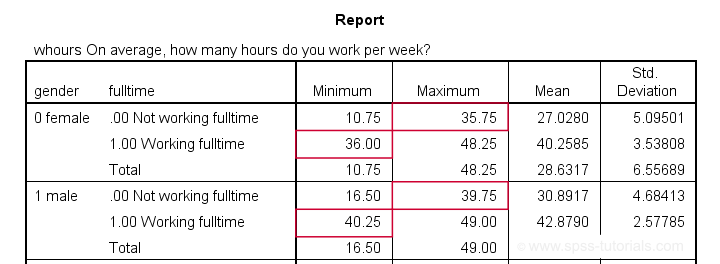In SPSS, IF computes a new or existing variable
for a selection of cases.
For analyzing a selection of cases, use FILTER or SELECT IF instead.
- Example 1 - Flag Cases Based on Date Function
- Example 2 - Replace Range of Values by Function
- Example 3 - Compute Variable Differently Based on Gender
- SPSS IF Versus DO IF
- SPSS IF Versus RECODE

Data File Used for Examples
All examples use bank.sav, a short survey of bank employees. Part of the data are shown below. For getting the most out of this tutorial, we recommend you download the file and try the examples for yourself.

Example 1 - Flag Cases Based on Date Function
Let's flag all respondents born during the 80’s. The syntax below first computes our flag variable -born80s- as a column of zeroes. We then set it to one if the year -extracted from the date of birth- is in the RANGE 1980 through 1989.
compute born80s = 0.
*Set value to 1 if respondent born between 1980 and 1989.
if(range(xdate.year(dob),1980,1989)) born80s = 1.
execute.
*Optionally: add value labels.
add value labels born80s 0 'Not born during 80s' 1 'Born during 80s'.
Result

Example 2 - Replace Range of Values by Function
Next, if we'd run a histogram on weekly working hours -whours- we'd see values of 160 hours and over. However, weeks only hold (24 * 7 =) 168 hours. Even Kim Jong Un wouldn't claim he works 160 hours per week!
We assume these respondents filled out their monthly -rather than weekly- working hours. On average, months hold (52 / 12 =) 4.33 weeks. So we'll divide weekly hours by 4.33 but only for cases scoring 160 or over.
sort cases by whours (d).
*Divide 160 or more hours by 4.33 (average weeks per month).
if(whours >= 160) whours = whours / 4.33.
execute.
Result

Note
We could have done this correction with RECODE as well: RECODE whours (160 = 36.95)(180 = 41.57). Note, however, that RECODE becomes tedious insofar as we must correct more distinct values. It works reasonably for this variable but IF works great for all variables.
Example 3 - Compute Variable Differently Based on Gender
We'll now flag cases who work fulltime. However, “fulltime” means 40 hours for male employees and 36 hours for female employees. So we need to use different formulas based on gender. The IF command below does just that.
compute fulltime = 0.
*Set fulltime to 1 if whours >= 36 for females or whours >= 40 for males.
if(gender = 0 & whours >= 36) fulltime = 1.
if(gender = 1 & whours >= 40) fulltime = 1.
*Optionally, add value labels.
add value labels fulltime 0 'Not working fulltime' 1 'Working fulltime'.
*Quick check.
means whours by gender by fulltime
/cells min max mean stddev.
Result
Our syntax ends with a MEANS table showing minima, maxima, means and standard deviations per gender per group. This table -shown below- is a nice way to check the results.

The maximum for females not working fulltime is below 36. The minimum for females working fulltime is 36. And so on.
SPSS IF Versus DO IF
Some SPSS users may be familiar with DO IF. The main differences between DO IF and IF are that
- IF is a single line command while DO IF requires at least 3 lines: DO IF, some transformation(s) and END IF.
- IF is a conditional COMPUTE command whereas DO IF can affect other transformations -such as RECODE or COUNT- as well.
- If cases meet more than 1 condition, the first condition prevails when using DO IF - ELSE IF. If you use multiple IF commands instead, the last condition met by each case takes effect. The syntax below sketches this idea.
DO IF - ELSE IF Versus Multiple IF Commands
do if(condition_1).
result_1.
else if(condition_2). /*excludes cases meeting condition_1.
result_2.
end if.
*IF: respondents meeting both conditions get result_2.
if(condition_1) result_1.
if(condition_2) result_2. /*includes cases meeting condition_1.
SPSS IF Versus RECODE
In many cases, RECODE is an easier alternative for IF. However, RECODE has more limitations too.
First off, RECODE only replaces (ranges of) constants -such as 0, 99 or system missing values- by other constants. So something like
recode overall (sysmis = q1).
is not possible -q1 is a variable, not a constant- but
if(sysmis(overall)) overall = q1.
works fine. You can't RECODE a function -mean, sum or whatever- into anything nor recode anything into a function. You'll need IF for doing so.
Second, RECODE can only set values based on a single variable. This is the reason why
you can't recode 2 variables into one
but you can use an IF condition involving multiple variables:
if(gender = 0 & whours >= 36) fulltime = 1.
is perfectly possible.
You can get around this limitation by combining RECODE with DO IF, however. Like so, our last example shows a different route to flag fulltime working males and females using different criteria.
Example 4 - Compute Variable Differently Based on Gender II
recode whours (40 thru hi = 1)(else = 0) into fulltime2.
*Apply different recode for female respondents.
do if(gender = 0).
recode whours (36 thru hi = 1)(else = 0) into fulltime2.
end if.
*Optionally, add value labels.
add value labels fulltime2 0 'Not working fulltime' 1 'Working fulltime'.
*Quick check.
means whours by gender by fulltime2
/cells min max mean stddev.
Final Notes
This tutorial presented a brief discussion of the IF command with a couple of examples. I hope you found them helpful. If I missed anything essential, please throw me a comment below.
Thanks for reading!
 SPSS TUTORIALS
SPSS TUTORIALS
THIS TUTORIAL HAS 61 COMMENTS:
By Sloan on May 13th, 2016
I have waves of data and I want to create a variable of the wave at which a subject is a certain age. For example all subjects with data at age 26 come from one of the waves (1-12), I would like to have a variable "index wave" which includes the number of the wave at which the subject was 26. Suggestions welcome!
By Ruben Geert van den Berg on May 14th, 2016
Hi Sloan!
A simple approach is using DATEDIFF in an IF command in a DO REPEAT command. For a working example, see SPSS - Comparing Date Variables Example. Perhaps you can edit it according to your needs.
Keep in mind that DATEDIFF truncates it outcomes: somebody who's 25 years and 364 days old, will be assigned 25 (years). I think that won't be a problem regarding your question but please do keep this in mind.
Hope that helps!
SPSS - Comparing Date Variables Example
By Peter on May 24th, 2016
Hi Ruben
IF Region="AUCKLAND REGION" AND AgeGroup="45-64" Weighting=1.26
with or without a "." generates "expression ends unexpectedly". What am I doing wrong?
By Ruben Geert van den Berg on May 25th, 2016
Hi Peter!
Your syntax looks fine and when I ran it, all was good. Could the problem be in a line before/after the one you posted? Or could you perhaps run
set printback on.and rerun the problem syntax and send me the surrounding output including the command itself?
By Nicholas Michalak on August 24th, 2016
I love how SPSS syntax appears on your website. How do you generate the html that makes it? Thank you!